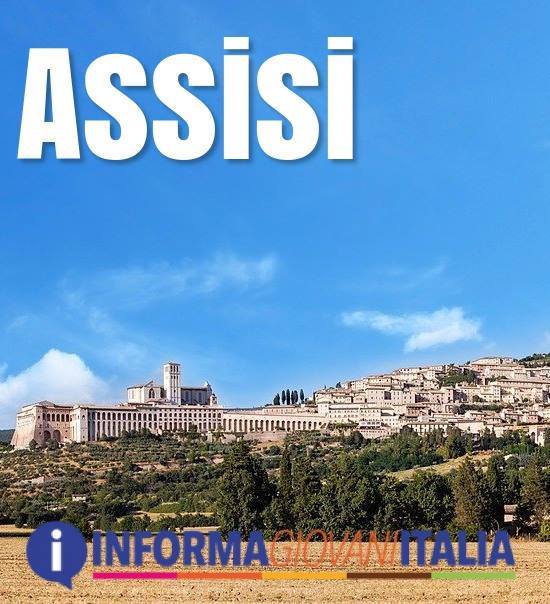|
VISITARE ASSISI INFORMAZIONI E GUIDA
|
Assisi
is one of the most famous Italian towns in the
world, thanks to its historical and cultural beauty
and because it is linked to the figure of one of the
most famous saints of Christianity, St. Francis,
but also to the figure of St. Clare. The
exceptional events in the life of the two famous
saints, and the spread of Franciscan ideology, are
the main feature of the city, which has been named a
center of spirituality and peace. |
|
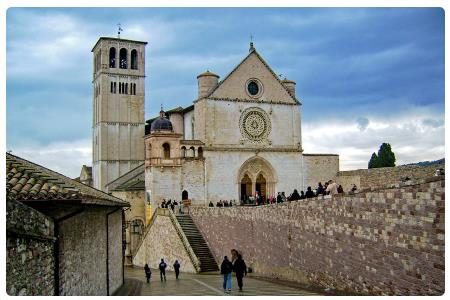 This
role of "City of Peace" is concretized every year in a march for
peace in the world. The Franciscan idea is present everywhere,
you can breathe in these streets, and has also influenced the
architecture and buildings (built of stone overlooking the rose,
from Mount Subasio), not only the great basilicas of
St. Francis and St. Clare. In the medieval village the
Franciscan buildings have become over the centuries centers of
pilgrimage and aggregation. This
role of "City of Peace" is concretized every year in a march for
peace in the world. The Franciscan idea is present everywhere,
you can breathe in these streets, and has also influenced the
architecture and buildings (built of stone overlooking the rose,
from Mount Subasio), not only the great basilicas of
St. Francis and St. Clare. In the medieval village the
Franciscan buildings have become over the centuries centers of
pilgrimage and aggregation.
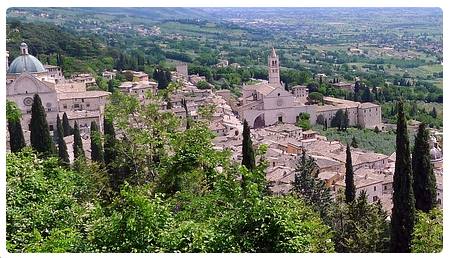 Its
alleys, squares and avenues surrounded by centuries-old cypress
trees are silent. It is not known if it is because of the
miracle of the Franciscan air that one breathes, but here
sometimes even the hordes of tourists walk calmly, with a
contemplative air and speaking with a certain respect, in a low
voice. Of course, even in Assisi there are now high fashion
boutiques with the usual designer clothes and horrible fake
antique shops that offer tourists souvenirs and typical products
using the most persuasive bad taste. But. and there is almost
always a but, when there is something that is too much out of
place in a place that is particularly dear to us, you can even
close your eyes momentarily (metaphorically) and then reopen
them when what is out of place we left behind. Then we find
Assisi, dreamed of and hoped for, the same timeless peace, the
same unrepeatable enchantment of a lookout in a twilight veiled
in fog, the intoxicating scent of Umbrian food. Its
alleys, squares and avenues surrounded by centuries-old cypress
trees are silent. It is not known if it is because of the
miracle of the Franciscan air that one breathes, but here
sometimes even the hordes of tourists walk calmly, with a
contemplative air and speaking with a certain respect, in a low
voice. Of course, even in Assisi there are now high fashion
boutiques with the usual designer clothes and horrible fake
antique shops that offer tourists souvenirs and typical products
using the most persuasive bad taste. But. and there is almost
always a but, when there is something that is too much out of
place in a place that is particularly dear to us, you can even
close your eyes momentarily (metaphorically) and then reopen
them when what is out of place we left behind. Then we find
Assisi, dreamed of and hoped for, the same timeless peace, the
same unrepeatable enchantment of a lookout in a twilight veiled
in fog, the intoxicating scent of Umbrian food.
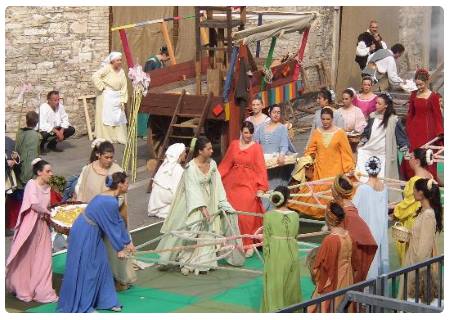 Assisi,
in addition to the Franciscan wonders and the rest of its past,
remains above all this: the simple and suggestive cribs,
scattered along the alleys under Christmas, the taste of broad
beans and pork rind (ancient Roman dish that served to put in
communication the living with the dead), the cabbage cooked in
the pan with oil, garlic and bread, the strong smell of
truffles, the beautiful devotional sweets with snakes
(propitiatory for eel fishing), the rocciata d'Assisi,
the pan caciato that you can see in the old shops (for
real), the beautiful tablecloths embroidered in blue with
"stitch assisi" with a unique effect of full and empty that
represents the typicality. And then a beautiful party not to be
missed, the Calendimaggio, which takes place in the night
between April 30 and May 1. Assisi,
in addition to the Franciscan wonders and the rest of its past,
remains above all this: the simple and suggestive cribs,
scattered along the alleys under Christmas, the taste of broad
beans and pork rind (ancient Roman dish that served to put in
communication the living with the dead), the cabbage cooked in
the pan with oil, garlic and bread, the strong smell of
truffles, the beautiful devotional sweets with snakes
(propitiatory for eel fishing), the rocciata d'Assisi,
the pan caciato that you can see in the old shops (for
real), the beautiful tablecloths embroidered in blue with
"stitch assisi" with a unique effect of full and empty that
represents the typicality. And then a beautiful party not to be
missed, the Calendimaggio, which takes place in the night
between April 30 and May 1.
This festival was born in the past to greet the return of spring
and, in all probability, resumes the ancient propitiatory rite
of "planting the maio" which in dialect means twig or flowering
bush. The aim is to recover the medieval tradition of amateur
songs. And that night, still today, musicians and singers stop
in the most characteristic places of the city where in the light
of torches, torches and lights, offer beautiful
sixteenth-century serenades accompanied by lutes, mandolins,
guitars and violas. The head of the city is represented by the
church of Santa Chiara, the tail by the Basilica of San
Francesco.
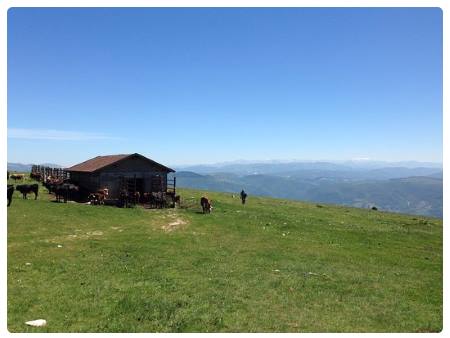 Assisi
is a town that today we will say, "on a human scale", with about
27 thousand inhabitants, located south-east of Perugia,
which is about 20 km. Located on the western side of Mount
Subasio, overlooking the valley enclosed by the rivers
Chiascio and Topino, and is washed by a small
tributary of Topino, which flows into the left bank of the
Tiber. The origins of the city probably date back to the second
century BC, although the area on which it stands was already
inhabited in prehistoric times. Around the first century BC it
became a Roman municipium and was surrounded by walls
that contained the town until the municipal period, when there
was a sudden and unstoppable expansion, and, as mentioned, the
birth of one of the most important characters of Christianity.
Most of the monuments are in fact dedicated to the memory of St.
Francis and Franciscanism, even in the female form carried out
by St. Clare and the Poor Clares. Assisi
is a town that today we will say, "on a human scale", with about
27 thousand inhabitants, located south-east of Perugia,
which is about 20 km. Located on the western side of Mount
Subasio, overlooking the valley enclosed by the rivers
Chiascio and Topino, and is washed by a small
tributary of Topino, which flows into the left bank of the
Tiber. The origins of the city probably date back to the second
century BC, although the area on which it stands was already
inhabited in prehistoric times. Around the first century BC it
became a Roman municipium and was surrounded by walls
that contained the town until the municipal period, when there
was a sudden and unstoppable expansion, and, as mentioned, the
birth of one of the most important characters of Christianity.
Most of the monuments are in fact dedicated to the memory of St.
Francis and Franciscanism, even in the female form carried out
by St. Clare and the Poor Clares.
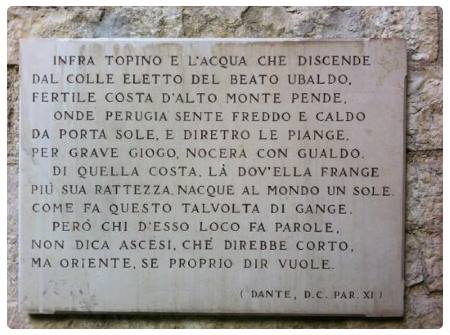 Dante
Alighieri cited Assisi in the Divine Comedy as the
birthplace of the Sun because of Francis, Patron Saint of Italy
and Clare. The area around Assisi was already inhabited in
Neolithic times. From the ninth century BC was the seat of a
small village founded by the Umbrians who, according to
archaeological findings, traded with the neighbors who lived
along the Etruscan western bank of the Tiber. Dante
Alighieri cited Assisi in the Divine Comedy as the
birthplace of the Sun because of Francis, Patron Saint of Italy
and Clare. The area around Assisi was already inhabited in
Neolithic times. From the ninth century BC was the seat of a
small village founded by the Umbrians who, according to
archaeological findings, traded with the neighbors who lived
along the Etruscan western bank of the Tiber.
In 1367 the city became part of the domains of the Papal
State until 1861, the year of the Unification of Italy. The
current structure of the city is still the medieval one,
survived over the centuries despite the terrible earthquakes
that cyclically hit the area. The renovation works are still in
progress following the earthquake of 1997, which caused so much
damage.
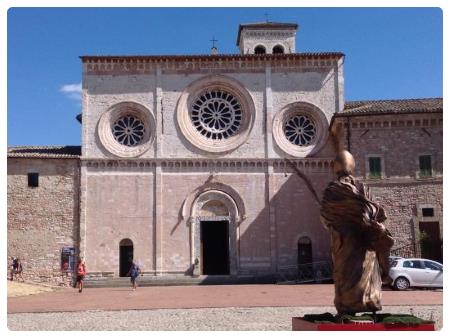 The
first church that can be seen entering the city from Porta
San Pietro is the homonymous Benedictine church of San
Pietro. Built at the end of the tenth century but greatly
altered in the '200, is particularly interesting for the purity
of the Romanesque style in which it was built. The facade has a
simple main portal, flanked by two small side doors and
surmounted by three rose windows. The austere interior, divided
into three naves by mighty pillars, was covered with decorations
and stuccoes removed in the twentieth century. The
first church that can be seen entering the city from Porta
San Pietro is the homonymous Benedictine church of San
Pietro. Built at the end of the tenth century but greatly
altered in the '200, is particularly interesting for the purity
of the Romanesque style in which it was built. The facade has a
simple main portal, flanked by two small side doors and
surmounted by three rose windows. The austere interior, divided
into three naves by mighty pillars, was covered with decorations
and stuccoes removed in the twentieth century.
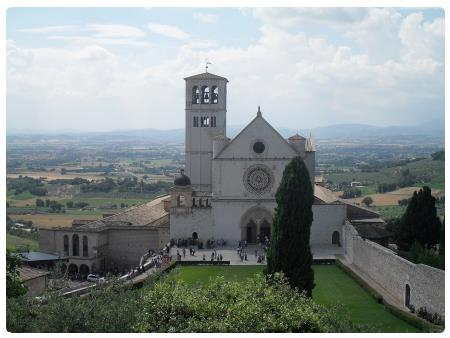 The
Basilica of San Francesco is divided into an upper
basilica and a lower basilica. Construction of the church began
on 17 July 1228, when Pope Gregory IX laid the first
stone. The lower body was finished in the spring of 1230 and in
the same year the body of St. Francis was laid there. The
upper body was completed in 1253, the year the church was
consecrated. The most important artists of the time, Cimabue,
Giotto, Simone Martini and Pietro Lorenzetti,
were called upon to decorate the walls. During the terrible
earthquake of '97 the vault of the upper basilica collapsed,
some frescoes by Giotto and Cimabue crumbled into
thousands of fragments, the about 5000sqm of thirteenth-century
frescoes that completely cover the walls of the Basilica were
covered with a thick layer of dust and the structure of the
church itself remained heavily damaged. Currently, the cleaning
of the undamaged frescoes and those of structural reinforcement,
carried out thanks to an exceptional investment in advanced
technologies, have been completed. The
Basilica of San Francesco is divided into an upper
basilica and a lower basilica. Construction of the church began
on 17 July 1228, when Pope Gregory IX laid the first
stone. The lower body was finished in the spring of 1230 and in
the same year the body of St. Francis was laid there. The
upper body was completed in 1253, the year the church was
consecrated. The most important artists of the time, Cimabue,
Giotto, Simone Martini and Pietro Lorenzetti,
were called upon to decorate the walls. During the terrible
earthquake of '97 the vault of the upper basilica collapsed,
some frescoes by Giotto and Cimabue crumbled into
thousands of fragments, the about 5000sqm of thirteenth-century
frescoes that completely cover the walls of the Basilica were
covered with a thick layer of dust and the structure of the
church itself remained heavily damaged. Currently, the cleaning
of the undamaged frescoes and those of structural reinforcement,
carried out thanks to an exceptional investment in advanced
technologies, have been completed.
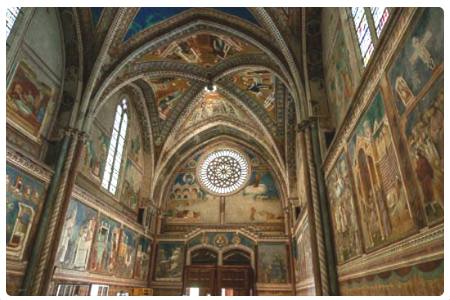 Taking
advantage of the works already underway, the basilica has been completely
restored, the choir has been relocated, the entrance compass and the organ
have been refurbished. In addition, two of Giotto's seven saints and the
sail of San Girolamo have regained their recognizable shape and have
been restored, while it is expected that within four years the manual
recomposition of the fragments of the eight saints of the voltone will be
completed. For the sail of San Matteo by Cimabue, on the other hand,
the 120,000 fragments are being recovered using a "virtual reassembly"
programme. From the basilica, Via San Francesco leads to Piazza del
Comune (Town Square), which houses interesting buildings from different
periods. Taking
advantage of the works already underway, the basilica has been completely
restored, the choir has been relocated, the entrance compass and the organ
have been refurbished. In addition, two of Giotto's seven saints and the
sail of San Girolamo have regained their recognizable shape and have
been restored, while it is expected that within four years the manual
recomposition of the fragments of the eight saints of the voltone will be
completed. For the sail of San Matteo by Cimabue, on the other hand,
the 120,000 fragments are being recovered using a "virtual reassembly"
programme. From the basilica, Via San Francesco leads to Piazza del
Comune (Town Square), which houses interesting buildings from different
periods.
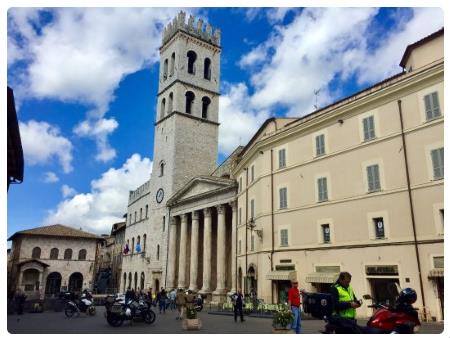 The
church of Santa Maria sopra Minerva stands out above all
others. It was built from a Roman temple from the first century,
of which six columns remain on the façade, the staircase and the
tympanum. Next to the church are the Torre del Popolo
(13th century) and the Palazzo del Capitano del Popolo,
built in 1282. On the opposite side of the square is the Palazzo
dei Priori, the seat of the municipality, consisting of three
buildings from different periods. In the oldest part there is
the Municipal Picture Gallery, still unusable because of
the damage suffered by the earthquake. The fountain at the
center of the square is eighteenth-century. The
church of Santa Maria sopra Minerva stands out above all
others. It was built from a Roman temple from the first century,
of which six columns remain on the façade, the staircase and the
tympanum. Next to the church are the Torre del Popolo
(13th century) and the Palazzo del Capitano del Popolo,
built in 1282. On the opposite side of the square is the Palazzo
dei Priori, the seat of the municipality, consisting of three
buildings from different periods. In the oldest part there is
the Municipal Picture Gallery, still unusable because of
the damage suffered by the earthquake. The fountain at the
center of the square is eighteenth-century.
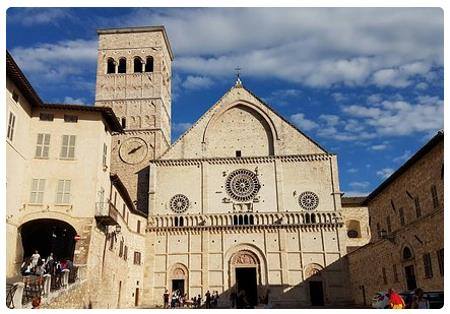 Via
San Rufino leads to the church of the same name, the
Cathedral of San Rufino. Perhaps one of the most significant
monuments of Romanesque art in Umbria, it was built on
pre-existing religious buildings, to house the remains of the
martyr Rufino. The facade is beautiful, decorated at the
base with lions and griffins, and at the top with three rosettes
and the symbols of the four Evangelists. In the interior with
three naves are visible the baptismal font, where they
were baptized St. Francis and St. Clare, and the Museum, while
in the apse is a choir of refined workmanship. To the right of
the apse we descend to the oratory, where St. Francis
retired to pray before preaching in the cathedral. Under the
Renaissance dome is the 19th century altar, where, according to
tradition, the remains of San Rufino are preserved. Below the
cathedral you can admire the crypt of a previous building, a
well 28 meters deep and the remains of a cloister from the
Carolingian era. Via
San Rufino leads to the church of the same name, the
Cathedral of San Rufino. Perhaps one of the most significant
monuments of Romanesque art in Umbria, it was built on
pre-existing religious buildings, to house the remains of the
martyr Rufino. The facade is beautiful, decorated at the
base with lions and griffins, and at the top with three rosettes
and the symbols of the four Evangelists. In the interior with
three naves are visible the baptismal font, where they
were baptized St. Francis and St. Clare, and the Museum, while
in the apse is a choir of refined workmanship. To the right of
the apse we descend to the oratory, where St. Francis
retired to pray before preaching in the cathedral. Under the
Renaissance dome is the 19th century altar, where, according to
tradition, the remains of San Rufino are preserved. Below the
cathedral you can admire the crypt of a previous building, a
well 28 meters deep and the remains of a cloister from the
Carolingian era.
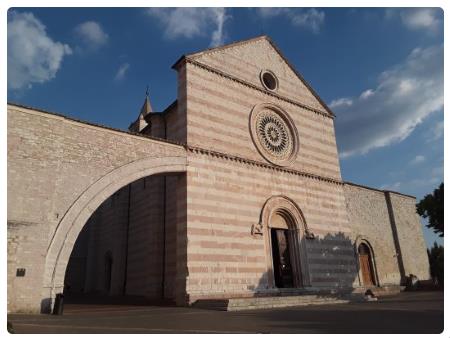 The
square-based bell tower dates back to the 11th century and has a
Roman cistern as its foundation. On Piazza Santa Chiara, overlooking
the valley, stands the thirteenth-century Basilica of Santa Chiara
dedicated to the saint, which lies in a small urn in the crypt. It is a
rather sober Gothic building with a facade of horizontal stripes of pink and
white stone, adorned with an elegant rose window. Even the interior, with a
single nave, is rather bare, but fragments of frescoes testify to the
original wealth of decoration. Interesting are the Chapel of the Crucifix,
with the Cross that according to legend spoke to Francis, and that of the
Sacrament, where there are frescoes of the school of Giotto. The Rocca
Maggiore was placed to guard the city in the second half of the
fourteenth century, taking advantage of the structure of a pre-existing
fortress, which were made many changes. Severely damaged by the earthquake,
the fortress is the subject of major restoration work. Just outside the
city, on the western side of Mount Subasio, is the Eremo delle
Carceri (Hermitage of the Prisons). Immersed in a dense forest of oaks,
is one of the most beautiful Franciscan places, where Francis and his
followers often climbed in meditation. You can see the caves where the monks
gathered in prayer, the refectory, the cells, the church of San
Bernandino, the chapel. The
square-based bell tower dates back to the 11th century and has a
Roman cistern as its foundation. On Piazza Santa Chiara, overlooking
the valley, stands the thirteenth-century Basilica of Santa Chiara
dedicated to the saint, which lies in a small urn in the crypt. It is a
rather sober Gothic building with a facade of horizontal stripes of pink and
white stone, adorned with an elegant rose window. Even the interior, with a
single nave, is rather bare, but fragments of frescoes testify to the
original wealth of decoration. Interesting are the Chapel of the Crucifix,
with the Cross that according to legend spoke to Francis, and that of the
Sacrament, where there are frescoes of the school of Giotto. The Rocca
Maggiore was placed to guard the city in the second half of the
fourteenth century, taking advantage of the structure of a pre-existing
fortress, which were made many changes. Severely damaged by the earthquake,
the fortress is the subject of major restoration work. Just outside the
city, on the western side of Mount Subasio, is the Eremo delle
Carceri (Hermitage of the Prisons). Immersed in a dense forest of oaks,
is one of the most beautiful Franciscan places, where Francis and his
followers often climbed in meditation. You can see the caves where the monks
gathered in prayer, the refectory, the cells, the church of San
Bernandino, the chapel.
Copyright © Informagiovani-italia.com. La
riproduzione totale o parziale, in qualunque forma, su qualsiasi supporto e con
qualunque mezzo è proibita senza autorizzazione scritta.
Se questa guida vi è piaciuta e volete dare una
mano a Informagiovani-italia.com aiutateci a diffonderla.
Dove si trova?
Ostelli Assisi
Ostelli Italia
Auberges de Jeunesse Italie
Hotel Assisi
Carte de Assise
Karte von Assisi
Mapa Assisi
Map of Assisi
Carte de
la Ombrie
Karte von Umbrien
Mapa Umbria
Map of Umbria
Carte d'Italie
Karte von Italien
Mapa Italia
Map of Italy |
